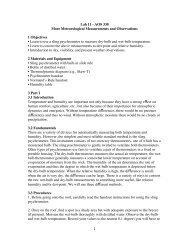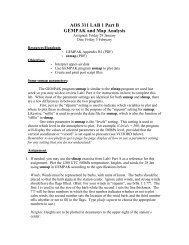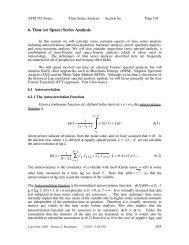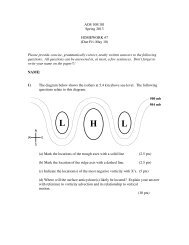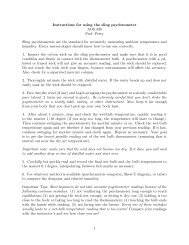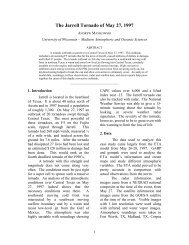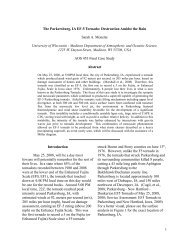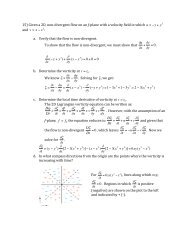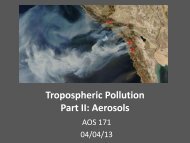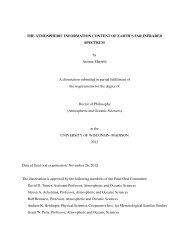R - University of Wisconsin MM5 Real Time Forecast and Forecast ...
R - University of Wisconsin MM5 Real Time Forecast and Forecast ...
R - University of Wisconsin MM5 Real Time Forecast and Forecast ...
Create successful ePaper yourself
Turn your PDF publications into a flip-book with our unique Google optimized e-Paper software.
Application <strong>and</strong> interpretation <strong>of</strong>adjoint-derivedsensitivities in synoptic-casestudiesMichael C. Morgan<strong>University</strong> <strong>of</strong> <strong>Wisconsin</strong>-Madison
AcknowledgementsLinda KellerKate La CasseDr. Hyun Mee Kim (KMA)Daryl T. Kleist (NCEP/NOAA)
Goals• Describe what an adjoint model is• Demonstrate adjoint applications to– Synoptic case studies– Diagnosis <strong>of</strong> ‘key’ analysis errors– Data assimilation• Discuss interesting research problems forwhich adjoint-based tools might have someutility
Goals• Provide synoptic interpretations for selectedforecast sensitivity gradients• Describe the “evolution” <strong>of</strong> sensitivitieswith respect to the forecast trajectory• Present a useful technique to displaysensitivities with respect to vector quantities• Discuss interesting research problems forwhich adjoint-based tools might have someutility
Relationship between the nonlinear model<strong>and</strong> its adjointxin→NonlinearModel→ → R x )xout( outx ' in→LinearModel→ x ' out∂ R∂ x in←AdjointModel←∂R∂ x out
∆R=How might adjoints be used?R∂R∂x( x + x′) − R( x′) = ⋅ x′+ H . O Tf f ff .f∂R∂R∂R∆ R ≅ δR = ⋅x′f = , x′f = , Px′0∂x∂x∂xfffadjoint modelδRT ∂R= P , x′∂xf0input perturbationAn adjoint model is useful in the estimation <strong>of</strong> a changein response function associated with arbitrary, but smallchanges in the input to the linearized model.
Application #1: Synoptic case studiesImpact studiesvs.Sensitivity studies
Impact studies or “what if?” experiments• Impact studies involve studying the effects a specificinitial <strong>and</strong>/or boundary perturbation (x 0 ) to an NWPmodel has on some aspect <strong>of</strong> a forecast.• While these perturbations are <strong>of</strong>ten chosen based on“synoptic intuition”, typically the precise choice <strong>of</strong> thelocation <strong>and</strong> structure <strong>of</strong> the imposed initialperturbations is not known.• The chosen perturbations may have very little impacton the weather system <strong>of</strong> interest.• As these studies are performed to assess theimportance <strong>of</strong> a particular synoptic feature, manyintegrations are needed to yield useful results.
Modeling System Used• <strong>MM5</strong> Adjoint Modeling System (Zou et al. 1997)with non-linear model state vector:x = ( u,v,w,T,p', qv)• All sensitivities were calculated by integrating theadjoint model “backwards” using dry dynamics,about a moist basic state.• The corresponding adjoint model state vector is:∂R∂x∂R= (∂u∂R∂R∂R∂R, , , , )∂v∂w∂T∂p'
Description <strong>of</strong> Case 1 <strong>and</strong> response functions• Cold frontal passage over the upper midwest duringthe 36h period beginning 1200 UTC 10 April 2003• Sensitivity gradients were calculated for the 36hour <strong>MM5</strong> forecast from Eta model initialconditions at 1200 UTC 10 April 2003 for threeresponse functions:– 1) average temperature over WI– 2) average north-south temperature differenceover northern WI– 3) average zonal wind over WI
Mean sea level pressure <strong>and</strong> temperature (σ=0.85)
Sensitivity with respect to initial conditions at 1200 UTC 10 April 2003∂R∂T∂R∂ w∂R∂u∂R∂v
36h temperature sensitivity evolution
∂R∂u∂R∂v700 hPa sensitivities with respect to u <strong>and</strong> vvalid at1200 UTC 11 April 2003 (f24)
∂R∂u∂R∂v700 hPa sensitivities with respect to u <strong>and</strong> vvalid at1200 UTC 11 April 2003 (f24)
Sensitivity with respect to derived variables∂R∂xx = ( u,v,w,T,p', qv)∂R= (∂u∂R∂R∂R∂R, , , , )∂v∂w∂T∂p'∂f∂Rfx in( x in )→( ) ←f -1Adjoint <strong>of</strong> f -1→ xin←∂ R∂x inζ →Inversion→ uψ , vψ∂R←∂ζAdjoint <strong>of</strong>Inversion←∂R∂u∂R,∂v
700 hPa sensitivity gradients valid at 1200 UTC 11 April 2003 (f24)∂R∂u∂R∂v∂R∂ζ∂R∂φ
Description <strong>of</strong> Case 2 <strong>and</strong> response function
Impact study <strong>of</strong> McTaggart-Cowan (2002)
Initial state (MSLP <strong>and</strong> 925hPa θ)
Initial state (250:300 hPa PV)
<strong>Forecast</strong> evolution
Final state
Sensitivity <strong>of</strong> 48h KE to vorticity
Application #2: Identification <strong>of</strong> ‘key’ analysis errorsIf the response function chosen is a (quadratic) measure <strong>of</strong>forecast error, the output <strong>of</strong> the adjoint model provides ameans <strong>of</strong> changing the initial conditions to determine aninitial condition which will minimize the forecast errorxnew0=x0−αC−1∂R∂x0
11 April 1994 ECMWF forecast bustVERIFYING ANALYSISDAY-5 FORECASTRabier et al. (1996)
Control <strong>and</strong> perturbed analyses
Rabier et al. (1996)Evolution <strong>of</strong>‘key’ analysiserrors
VERIFYING ANALYSISDAY-5 FORECAST“OPTIMAL” FORECASTRabier et al. (1996)
Application #3: 4DVAR data assimilationinitial timefinal timebackground fieldoriginal forecast
Application #3: 4DVAR data assimilationinitial timefinal timebackground fieldoriginal forecastobservationsobservation error
Application #3: 4DVAR data assimilationinitial timefinal timebackground fieldoriginal forecastobservationsobservation errornew initial conditionsnew forecast
La CASsE STUDY1200 UTC 13 February 2001NCEP final analysis (mslp) <strong>and</strong> ship<strong>and</strong> buoy observations <strong>of</strong> wind (ms -1 )<strong>and</strong> mean sea level pressureNCEP final analysis (blue) <strong>and</strong>36 hour <strong>MM5</strong> forecast (red) mslp
Water vapor image <strong>and</strong>satellite-derived wind vectors (ms -1 )0600 UTC 12 February 2001 300 hPa (yellow) <strong>and</strong> 400 hPa (blue)
Assimilation in sensitive regions1200 UTC 13 February 2001NCEP final analysis (blue) <strong>and</strong> 36 hour <strong>MM5</strong> forecast (red) mslpAll observations assimilatedat 0600 UTCObservations in sensitiveregions assimilated at 0600 UTC
Assimilation in insensitive regions1200 UTC 13 February 200136 hour forecast mslp (cont. – assim.)25,00020,000Number <strong>of</strong> observations15,00010,0005,0000Observations in insensitiveregions assimilated at 0600 UTC
Questions?<strong>Real</strong>-time forecast sensitivities may be found athttp://helios.aos.wisc.edu



